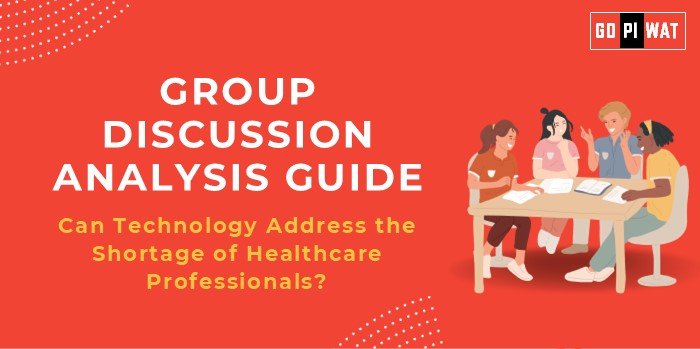📋 Group Discussion Analysis Guide: Can Technology Address the Shortage of Healthcare Professionals?
🌐 Introduction to the Topic
Opening Context: The global shortage of healthcare professionals poses a critical challenge, with the WHO estimating a deficit of 10 million workers by 2030. Technology is emerging as a potential solution, transforming healthcare delivery and accessibility.
Background: Over the past decade, technological innovations such as telemedicine, artificial intelligence (AI), and robotic assistance have gained traction in addressing healthcare gaps. Nations worldwide are increasingly investing in digital health ecosystems to bridge workforce shortages.
📊 Quick Facts and Key Statistics
- 🌍 Global Healthcare Worker Deficit: Estimated 10 million by 2030 (WHO).
- 📈 Telemedicine Growth: Market projected to reach $396 billion by 2027, driven by workforce gaps and rising healthcare demand.
- 🤖 AI in Diagnostics: AI reduces diagnostic time by 30%, enabling faster treatment decisions (JAMA, 2023).
- 🇮🇳 India’s Doctor-Patient Ratio: 1:1456 compared to the WHO’s recommended 1:1000.
- ⚙️ Robot-Assisted Surgeries: Increased by 18% annually, reflecting technology’s growing role in specialized care.
👥 Stakeholders and Their Roles
- 🏛️ Government Agencies: Establishing digital health policies and funding infrastructure, e.g., Ayushman Bharat Digital Mission in India.
- 💻 Private Tech Companies: Innovating AI tools, telemedicine platforms, and wearable devices.
- 🏥 Healthcare Providers: Integrating technology to optimize workflows and enhance patient care.
- 🧑⚕️ Citizens: Adopting digital tools for preventive and primary care.
- 🌍 International Organizations: WHO and World Bank advocating for digital health frameworks.
🏆 Achievements and Challenges
Achievements:
- 🩺 Telemedicine Success: Expanded access to healthcare in rural areas during the COVID-19 pandemic.
- ⚙️ AI Diagnostics: Improved accuracy in detecting diseases like cancer and cardiovascular conditions.
- 📚 E-learning Platforms: Upskilled healthcare workers through virtual training modules.
- ⌚ Wearable Technology: Enabled proactive health monitoring for millions globally.
Challenges:
- 🌐 Digital Divide: Limited access to technology in rural and underdeveloped areas.
- 🔒 Ethical Concerns: Data privacy and security issues in health records.
- 🔄 Resistance to Change: Adoption hesitancy among traditional practitioners.
🌏 Global Comparisons:
- 🇪🇪 Estonia: Digital health records accessible nationwide.
- 🇰🇷 South Korea: Advanced AI-based diagnostic tools integrated into healthcare systems.
📖 Case Study:
India’s eSanjeevani Telemedicine Service: Over 10 million consultations in underserved regions.
📚 Structured Arguments for Discussion
- ✅ Supporting Stance: “Technological tools like telemedicine are bridging the rural-urban healthcare divide, making care accessible where professionals are scarce.”
- ❌ Opposing Stance: “Technology cannot replace the human touch in patient care, and reliance may exacerbate inequities due to digital illiteracy.”
- ⚖️ Balanced Perspective: “While technology enhances efficiency and access, its integration must address gaps in digital infrastructure and ethical concerns.”
🎯 Effective Discussion Approaches
- 💡 Opening Approaches:
- “With telemedicine addressing over 5 million rural consultations annually in India, technology proves vital in filling gaps.”
- “The paradox of cutting-edge AI tools coexisting with a lack of basic healthcare facilities highlights complex challenges.”
- “Estonia’s digital healthcare system provides lessons in leveraging technology effectively.”
- 🛠️ Counter-Argument Handling: Use global examples (e.g., South Korea’s AI diagnostic systems) to demonstrate potential solutions.
🔍 Strategic Analysis of Strengths and Weaknesses
Strengths:
- 📊 Enhanced diagnostic accuracy.
- 🏥 Rural outreach.
- 💵 Cost efficiency.
Weaknesses:
- 💰 High initial costs.
- 🔒 Data security risks.
- 🌍 Limited adoption in low-resource settings.
Opportunities:
- ⚙️ AI and robotics expansion.
- ⌚ Wearable tech for chronic disease management.
Threats:
- ⚠️ Cybersecurity threats.
- 🌐 Widening inequities without infrastructure improvements.
🎓 Connecting with B-School Applications
- 🌟 Real-World Applications: Projects in healthcare operations optimization and cost-benefit analysis of telemedicine.
- ❓ Sample Interview Questions:
- “How can AI improve healthcare delivery in underserved regions?”
- “What are the challenges of implementing digital health solutions in emerging markets?”
- 📘 Insights for B-School Students: Explore the role of technology in public health initiatives and its implications for healthcare management.


